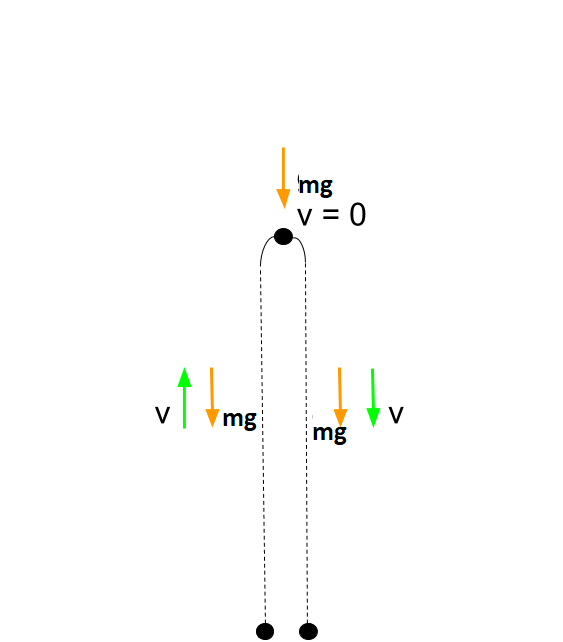
A pebble of mass 0.5g is thrown vertically upwards. Give the direction and magnitude of the net force on the pebble,
(a) During its upwards motion
(b) During its downwards motion
(c) At the highest point where it is momentarily at rest.
Do your answers change if the pebble was thrown at an angle of 45 with the horizontal direction? Ignore air resistance.
Answer
559.2k+ views
Hint: A pebble is thrown vertically upwards. Some force would have been required to toss the pebble upwards. After that initial push, throughout the motion, the pebbled will experience its own weight as a force. We know that the force of the weight is given by the formula given below
Formula used:
\[W=m\cdot g\]
Complete answer:
A pebble is thrown vertically upwards. Some force would have been required to toss the pebble upwards. After that initial push, throughout the motion, the pebbled will experience its own weight as a force.
We know that the force of the weight is given by
\[W=m\cdot g\]
The mass of the pebble is given, then the force it experiences will be given as
\[\begin{align}
& W=m\cdot g \\
& \Rightarrow W=0.5\times 10 \\
& \Rightarrow W=5N \\
\end{align}\]
So, the pebble will experience a force of 5 N, this force will be in the downward direction.

(a) During its upwards motion
The net velocity of the pebble will be in upwards direction and the pebble will experience a net force of 5N in the downward direction.
(b) During its downwards motion
The net velocity of the pebble will be in downwards direction and the pebble will experience a net force of 5N in a downward direction.
(c) at the highest point where it is momentarily at rest.
The net velocity of the pebble will be 0 and the pebble will experience a net force of 5N in a downward direction.
There will be no change if the pebble was thrown at an angle of 45 with the horizontal direction. The motion of the pebble will be identical vertically, the only change will be that the pebble will have a horizontal component to its velocity.
Note:
The motion of a projectile is quite similar to the motion of a body having one-dimensional motion in a vertical plane. Both of these bodies have only acceleration due to gravity in a vertically downward direction. The projectile has a horizontal component to its velocity but no acceleration in the horizontal direction and thus the horizontal remains constant throughout the motion of the body.
Formula used:
\[W=m\cdot g\]
Complete answer:
A pebble is thrown vertically upwards. Some force would have been required to toss the pebble upwards. After that initial push, throughout the motion, the pebbled will experience its own weight as a force.
We know that the force of the weight is given by
\[W=m\cdot g\]
The mass of the pebble is given, then the force it experiences will be given as
\[\begin{align}
& W=m\cdot g \\
& \Rightarrow W=0.5\times 10 \\
& \Rightarrow W=5N \\
\end{align}\]
So, the pebble will experience a force of 5 N, this force will be in the downward direction.

(a) During its upwards motion
The net velocity of the pebble will be in upwards direction and the pebble will experience a net force of 5N in the downward direction.
(b) During its downwards motion
The net velocity of the pebble will be in downwards direction and the pebble will experience a net force of 5N in a downward direction.
(c) at the highest point where it is momentarily at rest.
The net velocity of the pebble will be 0 and the pebble will experience a net force of 5N in a downward direction.
There will be no change if the pebble was thrown at an angle of 45 with the horizontal direction. The motion of the pebble will be identical vertically, the only change will be that the pebble will have a horizontal component to its velocity.
Note:
The motion of a projectile is quite similar to the motion of a body having one-dimensional motion in a vertical plane. Both of these bodies have only acceleration due to gravity in a vertically downward direction. The projectile has a horizontal component to its velocity but no acceleration in the horizontal direction and thus the horizontal remains constant throughout the motion of the body.
Recently Updated Pages
Why are manures considered better than fertilizers class 11 biology CBSE

Find the coordinates of the midpoint of the line segment class 11 maths CBSE

Distinguish between static friction limiting friction class 11 physics CBSE

The Chairman of the constituent Assembly was A Jawaharlal class 11 social science CBSE

The first National Commission on Labour NCL submitted class 11 social science CBSE

Number of all subshell of n + l 7 is A 4 B 5 C 6 D class 11 chemistry CBSE

Trending doubts
1 Quintal is equal to a 110 kg b 10 kg c 100kg d 1000 class 11 physics CBSE

What is Environment class 11 chemistry CBSE

Bond order ofO2 O2+ O2 and O22 is in order A O2 langle class 11 chemistry CBSE

How many squares are there in a chess board A 1296 class 11 maths CBSE

Distinguish between verbal and nonverbal communica class 11 english CBSE

The equivalent weight of Mohrs salt FeSO4 NH42SO4 6H2O class 11 chemistry CBSE




